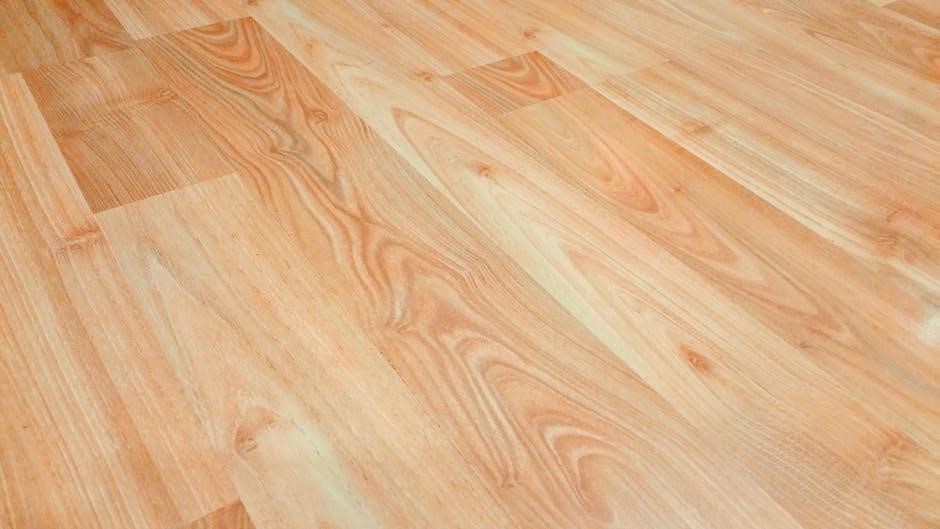Vinyl flooring thickness is a critical factor in determining its durability, comfort, and overall performance. Typically ranging from 2mm to 8mm, the thickness impacts resilience, sound insulation, and longevity, making it essential to choose the right option for your space and needs.
1;1 What is Vinyl Flooring?
Vinyl flooring is a versatile, synthetic flooring option made primarily from polyvinyl chloride (PVC). It is water-resistant, low-maintenance, and offers a wide range of designs to mimic natural materials like wood or stone. Available in tiles, planks, or sheets, vinyl flooring is a popular choice for residential and commercial spaces due to its durability and ease of installation. Its layered construction includes a wear layer, photographic layer, and backing material, ensuring resilience and aesthetic appeal for various applications.
1.2 Importance of Thickness in Vinyl Flooring
The thickness of vinyl flooring plays a vital role in its performance and longevity. Thicker floors generally offer better durability, sound insulation, and comfort underfoot. They are more resistant to wear and tear, making them ideal for high-traffic areas. The thickness also influences the flooring’s ability to handle subfloor imperfections and provides stability. Choosing the right thickness ensures the flooring meets specific needs, whether for residential or commercial use, balancing durability, cost, and aesthetic appeal effectively.
Understanding Vinyl Flooring Thickness
Understanding vinyl flooring thickness involves knowing its range, typically 2mm to 8mm, and how it impacts durability, comfort, and suitability for various applications.
2.1 Standard Thickness Ranges
Standard vinyl flooring thickness typically ranges from 2mm to 8mm, varying by type and application. Thinner options (2-4mm) suit low-traffic areas, while thicker (4-6mm) handle medium traffic. Commercial spaces often use 6-8mm for durability. The thickness directly impacts cost, durability, and sound insulation, making it crucial to align with specific needs and usage patterns for optimal performance and longevity.
2.2 Wear Layer vs. Overall Thickness
The wear layer, measured in mils (1 mil = 0.001 inches), is the clear top layer protecting against scratches and spills, while overall thickness includes all layers. A thicker wear layer (e.g., 6-20 mils) enhances durability, whereas overall thickness (2-8mm) impacts stability and sound insulation. Understanding both is crucial for balancing performance and cost, ensuring the flooring meets specific demands for resilience and comfort in various settings. Proper selection of these layers ensures long-term satisfaction and functionality.

Types of Vinyl Flooring and Their Thickness
Vinyl flooring comes in three main types: Luxury Vinyl Tiles (LVT), Vinyl Plank Flooring (LVP), and Sheet Vinyl, each with varying thickness to suit different installation needs.
3.1 Luxury Vinyl Tiles (LVT)
Luxury Vinyl Tiles (LVT) typically range in thickness from 2mm to 6.5mm, with 4mm being a common choice for residential use. Thicker LVT options, such as 5mm or 6.5mm, are ideal for high-traffic areas, offering enhanced durability and stability. The thickness of LVT impacts its ability to withstand wear and tear, making it crucial to select the appropriate thickness based on the intended use and expected foot traffic. Choosing the right thickness ensures optimal performance and longevity for your flooring.
3.2 Vinyl Plank Flooring (LVP)
Vinyl Plank Flooring (LVP) typically ranges in thickness from 4mm to 8mm or more. Thicker planks, such as 6mm to 8mm, offer superior durability and stability, making them ideal for high-traffic areas. Thinner options, like 4mm, are cost-effective and suitable for low- to moderate-traffic spaces. The thickness directly impacts the floor’s ability to handle wear and tear, with thicker planks providing better sound insulation and resistance to dents. Choosing the right LVP thickness ensures a balance between performance, comfort, and budget needs.
3.3 Sheet Vinyl Flooring
Sheet vinyl flooring typically ranges in thickness from 1.1mm to 3.3mm. Thinner options (1.1mm-1.6mm) are cost-effective and lightweight, while thicker sheets (3.3mm) offer enhanced durability and comfort. The thickness impacts its ability to handle wear and tear, with thicker sheets providing better sound insulation and resistance to heavy traffic. Sheet vinyl is versatile, suitable for both residential and commercial spaces, and its thickness can be chosen based on specific needs, balancing affordability and performance effectively.

The Wear Layer Explained
The wear layer is the top protective layer of vinyl flooring, measured in mils (6-30 mils). It shields against scratches and wear, with thicker layers offering enhanced durability.
4.1 What is the Wear Layer?
The wear layer is the top protective layer of vinyl flooring, typically measured in mils (6-30 mils). It shields the flooring from scratches, abrasions, and spills, ensuring longevity. This clear layer is part of a four-layer system, including the decorative layer, core, and backing. Its thickness directly impacts durability, with thicker layers offering better resistance to wear and tear. Proper maintenance of this layer is essential to preserve the flooring’s appearance and performance over time.
4.2 How Wear Layer Thickness Affects Durability
The thickness of the wear layer significantly impacts vinyl flooring’s durability. A thicker wear layer (6-30 mils) provides superior resistance to scratches, spills, and heavy foot traffic. It acts as a protective barrier, ensuring the flooring’s decorative layer remains intact. Thicker layers are ideal for high-traffic areas, offering extended lifespan and minimal maintenance. Conversely, thinner layers are better suited for low-traffic spaces. The wear layer’s thickness is a critical factor in determining the flooring’s overall resilience and performance under various conditions.
Factors to Consider When Choosing Thickness
When selecting vinyl flooring thickness, consider traffic patterns, subfloor conditions, budget, and intended use. These factors ensure optimal durability, comfort, and performance for your specific needs and space.
5.1 Traffic and Usage Patterns
Assessing traffic and usage patterns is vital when choosing vinyl flooring thickness. High-traffic areas, like kitchens or living rooms, require thicker flooring (4-6mm) for durability. Low-traffic spaces, such as bedrooms, can use thinner options (2-4mm). Commercial settings with heavy foot traffic may need 6-8mm thickness for optimal performance. Matching the flooring thickness to traffic ensures longevity and prevents premature wear, enhancing comfort and functionality in both residential and commercial environments.
5.2 Subfloor Requirements
The condition and type of subfloor significantly influence the choice of vinyl flooring thickness. Thicker vinyl flooring (4mm and above) can tolerate minor subfloor imperfections, while thinner options (2-3mm) require a smoother, more even surface. For uneven subfloors, thicker vinyl or additional underlayment may be necessary. Ensuring the subfloor meets the manufacturer’s requirements is crucial for a stable and long-lasting installation. Proper subfloor preparation enhances durability and prevents issues like buckling or uneven wear, ensuring optimal performance in both residential and commercial settings;
5.3 Budget Considerations
Budget plays a significant role in selecting vinyl flooring thickness. Thicker options (4mm+) are generally more expensive but offer greater durability and sound insulation, reducing long-term replacement costs. Thinner vinyl (2-3mm) is more affordable but less robust, making it suitable for low-traffic areas. Balancing thickness with budget ensures cost-effectiveness while meeting performance needs. Additionally, installation costs may vary depending on thickness, as thicker flooring might require additional underlayment for uneven subfloors. Evaluating these factors helps in making a financially sound decision for your space.
Thickness Recommendations by Application
Vinyl flooring thickness varies by application. Residential spaces often use 2-4mm for low traffic and 4-6mm for high traffic, while commercial areas require 5-8mm for durability and performance.
6.1 Residential Vinyl Flooring
Residential vinyl flooring typically ranges from 2mm to 6mm in thickness. For low-traffic areas like bedrooms, 2-4mm is sufficient, while high-traffic spaces such as kitchens and living rooms benefit from 4-6mm. Thicker options provide better durability, sound insulation, and comfort underfoot. Choosing the right thickness ensures a balance between cost and performance, making vinyl flooring a practical choice for homeowners seeking long-lasting and comfortable flooring solutions.
6.2 Commercial Vinyl Flooring
Commercial vinyl flooring requires thicker options to withstand heavy foot traffic and equipment. Typically, 6mm to 8mm thickness is recommended for high-traffic areas, ensuring durability and longevity. Thicker floors provide better sound insulation and resistance to wear and tear. For extreme conditions, some commercial vinyl flooring can exceed 8mm, offering enhanced protection and stability. Selecting the appropriate thickness ensures the flooring can handle the demands of a commercial environment while maintaining comfort and performance over time.
Impact of Thickness on Performance
Vinyl flooring thickness directly influences its durability, lifespan, and comfort. Thicker floors offer enhanced resilience, better sound insulation, and improved stability, ensuring optimal performance under various conditions.
7.1 Durability and Lifespan
Vinyl flooring thickness significantly impacts its durability and lifespan. Thicker floors, typically ranging from 4mm to 8mm, offer superior resistance to scratches, dents, and wear, making them ideal for high-traffic areas. A thicker wear layer further enhances resilience against daily stress, extending the flooring’s lifespan. While thinner options (2mm-4mm) are suitable for low-traffic spaces, they may not withstand heavy use as effectively. Investing in the right thickness ensures long-term performance and minimizes the need for premature replacements.
7.2 Sound Insulation and Comfort
Vinyl flooring thickness plays a key role in sound insulation and comfort. Thicker floors, typically 4mm and above, provide better sound absorption, reducing noise between rooms and floors. This makes them ideal for multi-level homes or busy households. Additionally, thicker vinyl offers a softer feel underfoot, enhancing comfort during prolonged standing or walking. The cushioning effect of thicker planks also helps mask minor subfloor imperfections, creating a more pleasant living or working environment overall.

Installation and Thickness
Installation complexity increases with thicker vinyl flooring, requiring specialized tools and more labor. Thinner options are easier to cut and handle, ensuring a smooth process with proper subfloor preparation.
8.1 How Thickness Affects Installation
Vinyl flooring thickness significantly impacts the installation process. Thicker options (4mm-8mm) are more durable but require specialized tools and adhesives, making installation more complex. Thinner vinyl (2mm-3mm) is lighter, easier to cut, and often suitable for DIY projects. The thickness also influences the method of installation, such as glue-down, click-lock, or loose-lay systems. Proper subfloor preparation is crucial, as thicker vinyl may hide minor imperfections, while thinner styles demand a smoother surface for optimal performance.
8.2 Special Considerations for Different Thicknesses
Different vinyl flooring thicknesses require tailored installation approaches. Thicker vinyl (4mm-8mm) may need stronger adhesives and specialized tools, while thinner options (2mm-3mm) are easier to handle but demand precise subfloor preparation. For heavy-traffic areas, thicker planks provide stability but are harder to cut. Thinner vinyl is ideal for low-traffic spaces and can be installed using simpler methods like peel-and-stick. Each thickness also influences the choice of underlayment and installation techniques to ensure a seamless and durable finish.

Maintenance and Thickness
Thicker vinyl flooring is more durable and resistant to scratches, reducing the need for frequent repairs. Regular cleaning and protective measures ensure longevity, regardless of thickness.
9.1 Caring for Different Thicknesses
Proper care for vinyl flooring varies by thickness. Thicker floors (4mm+) are more durable and require less maintenance, while thinner options (2-3mm) need gentle cleaning to avoid damage. Regular sweeping and mopping with mild detergents are essential for all thicknesses. Avoid harsh chemicals, as they can damage the wear layer. For thinner vinyl, use soft cleaning tools to prevent scratches. Protective pads on furniture legs can also help reduce wear, ensuring longevity regardless of thickness.
9.2 Repair and Replacement Guidelines
Repairing or replacing vinyl flooring depends on its thickness and damage severity. Thicker floors (4mm+) can often be repaired locally, while thinner options may require full replacement. Scratches or dents in the wear layer can sometimes be buffed out, but deep damage may necessitate new installation. If the wear layer is compromised, replacement is usually the best option. Always assess the subfloor for damage before reinstalling, ensuring a smooth and durable surface. Proper repair and replacement extend the lifespan of your vinyl flooring.
Vinyl flooring thickness plays a pivotal role in its performance, durability, and comfort. Understanding the differences in thickness, from 2mm to 8mm, helps homeowners and professionals make informed decisions. Thicker options offer greater resilience and sound insulation, while thinner choices are cost-effective for low-traffic areas. Considering factors like wear layer thickness, subfloor conditions, and budget ensures the right choice. By selecting the appropriate vinyl flooring thickness, you can enjoy a long-lasting, comfortable, and aesthetically pleasing floor that meets your specific needs and enhances your space.




